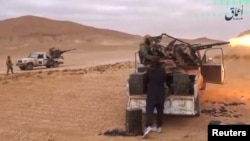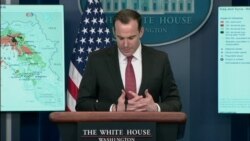Under pressure from unrelenting airstrikes and increasingly capable forces on the ground, the Islamic State terror group is having trouble mustering a fighting force capable of holding onto its self-declared caliphate.
New U.S. estimates put the number of IS "battle ready" fighters in Iraq and Syria at just 12,000 to 15,000, less than half of what the terror group was able to field at its height.
The latest intelligence puts the number of IS fighters "at the lowest point it's ever been," U.S. Special Presidential Envoy Brett McGurk told White House reporters Tuesday, adding the terror group "is unable to replenish its ranks."
WATCH: McGurk Talks about IS Numbers
Previous U.S. military and intelligence estimates, long considered by many experts to have been overly conservative, had put the size of the IS force at as many as 33,000. And bolstered by a steady influx of foreign fighters, for a time the group was able to replace fighters at the rate they were being killed.
But increased cooperation from Turkey and others has helped shut down many of the transit routes into Iraq and Syria, allowing the combination of more than 17,000 airstrikes and emboldened Iraqi, Kurdish and other Arab forces to take their toll.
Just last week, a senior U.S. military official said airstrikes alone had killed at least 50,000 IS fighters, saying the actual number was likely higher.
Still, many in the U.S. military and intelligence communities have urged caution when citing such numbers, explaining the strategies that made IS effective rarely relied on brute force.
"ISIL has integrated a range of asymmetrical tactics into its military strategy," a U.S. counterterrorism official told VOA, using an acronym for Islamic State.
Even IS's use of explosives, whether in the form of IEDs (improvised explosive devices) or in the form of bombs strapped to suicide attackers, has been designed to "instill fear and deter adversaries," rather than fight them head on, the official said.
Recent developments and other assessments are also stirring doubt that IS is nearing its end.
Despite having lost about 61 percent of the territory it once possessed in Iraq, IS still controls "huge swaths" of land, a U.S. official told VOA on condition of anonymity.
And even the ground campaign to retake the IS stronghold of Mosul has slowed as Iraqi forces have edged closer to the city center, encountering fierce resistance.
"By our calculations, we think we have killed or badly wounded over 2,000 [IS fighters]," the commander of Combined Joint Task Force Inherent Resolve, Lt. Gen. Stephen Townsend, said earlier this week in Iraq.
But Iraqi forces have also taken heavy casualties, and Townsend admitted as many as 5,000 IS fighters remain in Mosul, roughly the same number thought to have been left to defend the city as the Iraqi-led operation got underway two months ago.
"I doubt all estimates of ISIS's manpower," said Thomas Joscelyn, a senior fellow at the Foundation for Defense of Democracies, using an acronym for the terror group. "The estimates have been quite clearly wrong going back to 2014 and even before. I have no reason to think the estimates are any better now."
Joscelyn's own estimates put the size of the Islamic State fighting force at its peak at possibly more than 50,000. Other analysts and diplomats suggested the numbers might have been higher.
Yet no matter what the IS fighter numbers are now, "just be careful about writing them off," Joscelyn warned. "They are clearly able to still muster for battle."
Perhaps the best illustration of that has been the IS offensive this week to capture the Syrian city of Palmyra, wresting it back Sunday from Syrian regime forces backed by Russian air power.
Subsequent video distributed on social media by IS's Amaq News Agency on Wednesday showed fighters taking control of the nearby Russian airbase, gaining access to munitions and other supplies.
"That should give us pause," said Jennifer Cafarella, a Syria expert at the Institute for the Study of War.
"The U.S. should be similarly concerned on the Iraq side of the border that our metrics for assessing ISIS's strength have been incorrect thus far."











